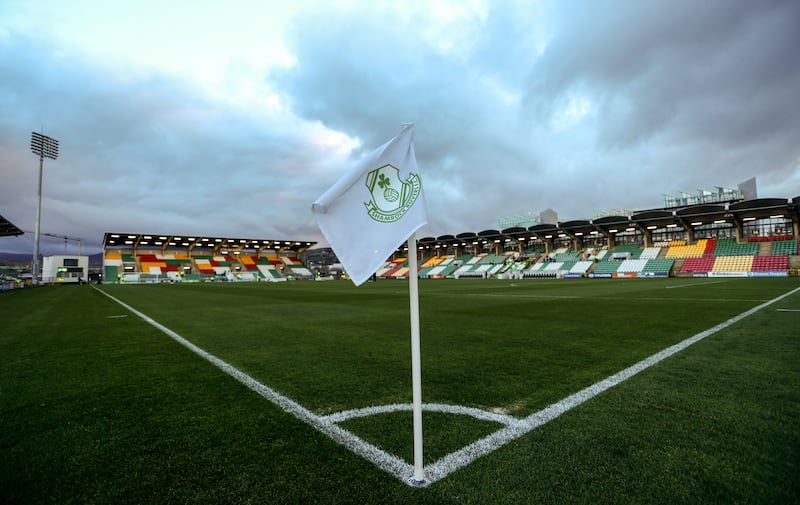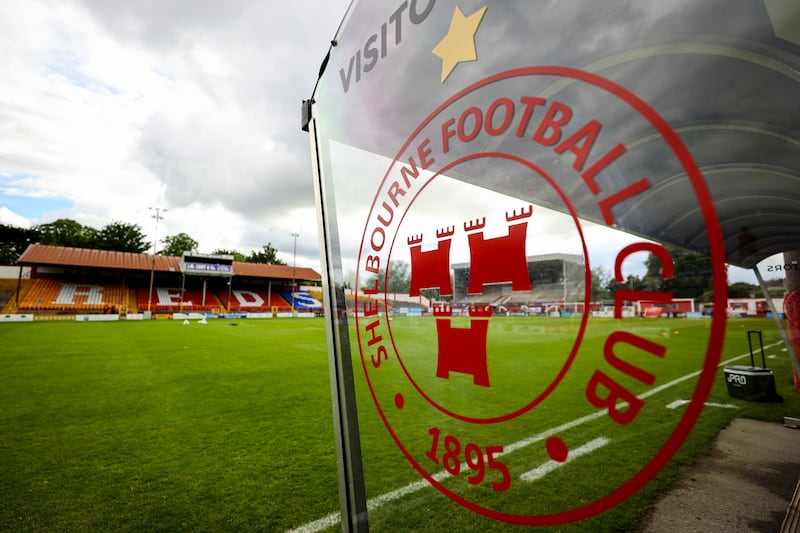Some bright spark needs to pen a book entitled: ‘How Ireland works, through the prism of stadia development (or lack thereof).’
“The League of Ireland facilities across the board are horrific when you compare them to Gaelic,” observed Damien Duff in November 2021. “Who is responsible and where has it gone wrong? That’s the future of Irish football and it’s poor, so poor.”
Facilities beget European nights, or is it the other way around? Either way, Irish football’s chronic lack of suitable venues for the Europa League qualifiers runs parallel, yet in stark contradiction, to the past two summers of progress on the pitch.
Same goes for Dundalk reaching the Europa group stages under Stephen Kenny. Oriel Park remains unfit for purpose. RTÉ hesitates to send an Outside Broadcast truck up the east coast due to health and safety concerns.
Scotland v Ireland: TV details, kick-off time and team news for Sunday’s Murrayfield clash
Dave Hannigan: Is the Super Bowl what passes for culture in modern America?
Gordon D’Arcy on Ireland’s perfect start and a Murrayfield history lesson
Seán Moran: Hurling may regard the FRC as an irrelevance but history suggests otherwise
Optics matter. Dalymount Park is a pile of lovely bones draped in colourful graffiti. Richmond Park and its three-sided terrace forced St Patrick’s Athletic to use Tallaght Stadium to host CSKA Sofia.
Similarly, Bohemians switched to the Aviva last year for three matches RTÉ overlooked as the national broadcaster managed to unite rival League of Ireland clubs quicker than a decade of gaslighting by John Delaney’s FAI could manage.
“Irish football looks so much better played in a good stadium,” tweeted Bohs president John O’Connor. “Clubs, the FAI and the Government got to fast track this.”
In a world exclusive, Rovers readily agree.
“I think everyone is looking in the right direction and these things don’t happen overnight but the pace could be much, much faster,” said Mark Lynch, Shamrock Rovers’ board director.
“Europe does shine a light on the workings of clubs and their facilities. The Dalymount project was meant to be a legacy of Euro 2020 and we are back to a planning phase in 2022.”
Lansdowne Road is too large to be the answer, although Rovers will probably reroute to Dublin 4 should they hook a Manchester United or Arsenal by overcoming Hungarian champions Ferencváros (both legs are live on RTÉ). If not, West Ham or Fiorentina would pack Tallaght to the rafters.
When construction of the 2,500 all-seater north stand swells capacity to 10,500 in July 2023, Tallaght will be the shining light for others to follow.
Rovers currently average around 6,000, which should increase alongside steady European progress under a solid structure. Stephen Bradley and Stephen McPhail run the football side of the house, while chairman and BDO partner Ciarán Medlar oversees a club that never boasts about Robbie Keane’s quiet relationship or Dermot Desmond’s cautious investment.

The current €11.5 million refurbishment is funded by South Dublin County Council. As is the way across Europe, Rovers are anchor tenants.
“Tallaght has grown up alongside Rovers into a fantastic stadium since 2009,” continued Lynch. “When we go abroad, even in Ludogorets [in Bulgaria], the stadium [Huvepharma Arena] is relatively small at 10,000, but what they have done is develop the infrastructure from media facilities to hospitality to medical rooms to the standard of a 60,000 seater stadium. It is first class.
“None of this is beyond us. That has to be our objective as a league.”
Irish clubs keep punching above their weight, especially St Pat’s, but equally Sligo Rovers after John Russell’s side outfoxed Motherwell. But the cringe factor is palpable on every away leg as municipal builds in Malta, Bulgaria, Norway, Slovenia and Hungary highlight a lack of progress by the FAI, the Irish Government and city councils during Irish soccer’s boom years.
Dusty facilities stymie the emergence of strategically-minded coaches like Bradley, Tim Clancy, Russell, Duff and Ruaidhrí Higgins, who are working with teenage talent blocked by Brexit from entering the labyrinth of English football.
“We have a model, from our travels, as South Dublin develops Tallaght and I know Dublin City Council [DCC] are working with Shels, Pats and Bohs,” said Lynch, noting that Rovers are continually expanding their leased training facility at Roadstone.
Straight after Sligo Rovers’ famous 1-0 defeat of Motherwell, club chairman Tommy Higgins and a gang of volunteers went about picking up all the rubbish and patching The Showgrounds together so Uefa wouldn’t force a 420km round trip to Tallaght to entertain Vikings Stavanger of Norway.
This autumn Rovers will seek planning permission from Sligo County Council for an €18 million (and rising) project to revamp the stadium and create a training centre nearby.
“That’s the way it is done across Europe,” said Higgins. “Municipally-built stadiums rented by the clubs. Governments would argue money has gone into rugby and Gaelic but up in Norway there is loads of indoor sports and the alpine stuff, shooting and skiing.
“Viking have a wonderful stadium funded by the local authority in Stavanger. I think they have a €12 million budget versus our €1.7 million budget so it’s a different league but this is part and parcel of every European city’s budget.
“The Showgrounds have been there forever, we are just upgrading it. There is a clear path and being greedy I would like it done before 2028.”
To understand how Ireland works, take a visit to Leinster League side Tullamore FC, opened in July 2008 by then taoiseach and local TD Brian Cowan, to witness a superior set-up than most League of Ireland clubs.

Those inside the football tent have not sat idle, nor has DCC and their chief executive Owen Keegan. The wires are intertwined as Keegan’s assistant ceo, Richard Shakespeare, is on the FAI board and direct access to the highest echelons of Government come in the form of Robert Watt, the Secretary General of the Department of Health, who is also a board member.
Nobody is denying the need to “fast track” mass upgrades with the FAI promising a long-term strategy to “co-fund” infrastructural improvements in their strategic vision (2022-25).
“The type of stadium Finn Harps may build may become the prototype for the future,” said FAI ceo Jonathan Hill last February. “Broadly speaking, we might end up saying, ‘We need 15 grounds that hold 5,000-6,000 and five that are 10,000 plus,’ for example.”
The time for broadly speaking is long gone. Still, all the right noises are being made to show a will exists to guide football facilities out of the dark ages.
Unfortunately, Irish society has never operated on will alone. The builders and a political class nonplussed by football still need a gentle push.
Even Michael D, the poet-politician turned President, is a football fan, but it was his comments last June that resonate – 100 years since the Free State was established, an Uachtarán broke the chains of protocol to attack Ireland’s “great, great failure” as a nation.
“Housing and the basic needs of society should never have been left to the market place,” said Higgins.
To quote The Wire creator David Simon’s coherent screenplays about each branch of Baltimore city, “all the pieces matter” as century old monoliths begin to thaw.
One slight problem. The recent economic downturn has the construction industry creaking under soaring inflation. This goes to the crux of the stadia matter; Bohemians remain positive despite Dalymount Park’s refurbishment getting bumped until 2026, after the ground-sharing idea was sunk by Shelbourne convincing DCC to ‘Save Tolka Park’ from the apartment blight.
So, in an Irish twist that makes little sense anywhere else, two venerable football institutions took leave of an uneasy alliance. Separated by a two kilometre stroll across the Royal Canal, ideally come 2030 Tolka and Dalyer with illuminate Friday nights on the northside.
Imagine.
Witnessing Shels return to the Premier Division has proved fascinating and not just because a street footballer from yesteryear is learning how to coach, manage, recruit and house his young squad.
Duff is a box-office draw that domestic soccer has not known since Johnny Giles came home, and Shels have steady hands on the tiller in Andrew Doyle as chairman and David O’Connor, the ex-player turned ceo, with the club announcing “significant equity investment” from US-Irish firm Closebreak Ltd.
The club’s undulating progress under Duff remains encouraging but Tolka Park feels like you are entering a time machine. The 1890s tannoy scratches records as you walk into a shed (the main stand) to be greeted by a warm welcome without fail.
It has not changed since 40-something correspondents began freelancing in their 20s. Duffer has already eviscerated the standstill while he spent 20 years inside English cathedrals.
But this is the norm.















